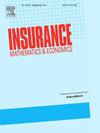Valuation of variable annuity portfolios using finite and infinite width neural networks
IF 2.2
2区 经济学
Q2 ECONOMICS
引用次数: 0
Abstract
Direct valuation of variable annuity guarantees relies on nested simulation, which is computationally costly. One way of feasibly valuing large portfolios relies on a two-step process in which such computationally intensive valuations are only performed on a set of carefully chosen representative policies. These values are then used to train a predictive model to obtain those for the remainder of the portfolio. This is known as the metamodeling framework. We empirically demonstrate that, when used as the predictive model, neural networks outperform state-of-the-art tree-based methods in terms of valuation accuracy. Further, we introduce Neural Tangent Kernel (NTK) regression as an easier-to-use and better-performing alternative to standard neural networks. NTK regression is equivalent to fitting the corresponding neural network with layers of infinite width, sidestepping the need to specify the number of nodes. As a kernel regression method, it is also easier to optimize, simplifying greatly the tuning process. We demonstrate that, in the setting of variable annuity valuation, NTK regression delivers significantly better empirical performance compared to finite-width networks.
基于有限和无限宽度神经网络的可变年金组合估值
可变年金担保的直接估值依赖于嵌套模拟,计算成本高。对大型投资组合进行估值的一种可行方法依赖于一个两步过程,在这个过程中,这种计算密集型的估值只针对一组精心挑选的代表性政策进行。然后用这些值来训练一个预测模型,以获得投资组合其余部分的值。这被称为元建模框架。我们的经验证明,当用作预测模型时,神经网络在估值准确性方面优于最先进的基于树的方法。此外,我们介绍了神经切线核(NTK)回归作为一个更容易使用和更好的性能替代标准神经网络。NTK回归相当于用无限宽的层来拟合相应的神经网络,回避了指定节点数量的需要。作为一种核回归方法,它也更容易优化,大大简化了调优过程。我们证明,在可变年金估值的设置下,NTK回归比有限宽度网络提供了显着更好的经验表现。
本文章由计算机程序翻译,如有差异,请以英文原文为准。
求助全文
约1分钟内获得全文
求助全文
来源期刊

Insurance Mathematics & Economics
管理科学-数学跨学科应用
CiteScore
3.40
自引率
15.80%
发文量
90
审稿时长
17.3 weeks
期刊介绍:
Insurance: Mathematics and Economics publishes leading research spanning all fields of actuarial science research. It appears six times per year and is the largest journal in actuarial science research around the world.
Insurance: Mathematics and Economics is an international academic journal that aims to strengthen the communication between individuals and groups who develop and apply research results in actuarial science. The journal feels a particular obligation to facilitate closer cooperation between those who conduct research in insurance mathematics and quantitative insurance economics, and practicing actuaries who are interested in the implementation of the results. To this purpose, Insurance: Mathematics and Economics publishes high-quality articles of broad international interest, concerned with either the theory of insurance mathematics and quantitative insurance economics or the inventive application of it, including empirical or experimental results. Articles that combine several of these aspects are particularly considered.
 求助内容:
求助内容: 应助结果提醒方式:
应助结果提醒方式:


